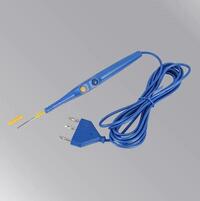Safe Use of Electrosurgical Pencil
-
Seven tests before surgery
1. Check the condition of the power cord; the power cord may be damaged due to slip knots, excessive pulling, wheel rolling, etc.
2. Check the accessories and connections; check the integrity of the connection, and the one-time accessories are strictly for one-time use. Broken, broken or defective accessories are prohibited. Make sure all accessories are connected correctly.
3. Check whether the patient wears metal jewelry and has tattoos;
Rings, necklaces, earrings, denture umbilical rings, and pudendal piercings can be hooked into electrical circuits, increasing the risk of burns. Tongue pins can damage the endoscope and hinder intubation in an emergency. In tattoos, the ink (particularly red) often contains metallic components that may conduct electricity or be a conductor of heat. It is recommended to remove all perforated or non-perforated jewelry, if the jewelry cannot be removed, it is recommended to use bipolar technology first. When single-stage must be used, avoid the current loop flowing through the metal jewelry. By covering the jewelry with gauze, avoid direct contact between the skin and the jewelry, and do not touch the jewelry with an electric knife pen to prevent the residual heat from being transmitted to the jewelry and causing burns.
4. Check whether the patient has a pacemaker.
What if the patient has buried metal objects, pacemakers, cochlear implants, hearing aids? For patients with cardiac pacemakers or metal implants, high-frequency electrocautery (can be used under the guidance of the manufacturer or a cardiologist) is prohibited or used with caution, or bipolar electrocautery is used instead. If a monopolar electrocautery is needed, the lowest effective power and the shortest time should be used; the position of the negative electrode plate of the circuit should be close to the surgical site; when choosing the position of the negative electrode plate of the circuit to be pasted, let the current main circuit avoid metal implants; strengthen monitoring, Closely observe the patient's condition. For patients with cardiac pacemakers, bipolar coagulation and low-power operation should be used preferentially under the guidance of professionals, to avoid loop current passing through the heart and pacemaker, and to keep the leads away from the pacemaker and its leads as far as possible. Patients should be examined separately after surgery. For patients with cochlear implants undergoing head and neck surgery, if there is no cochlear external reference electrode, monopolar cannot be used, and bipolar can be used. Bipolar contact with implants is strictly prohibited. High-frequency alternating current leakage may interfere with the hearing aid's reception of radio waves, and may damage two-piece hearing aids, making them unsuitable for electrosurgery.
5. Check the patient placement. The patient should not be in contact with conductive objects, such as operating table and metal infusion stand. The patient should be placed in an electrically insulated position, kept dry, pay attention to catheterization, and do not use wet sheets. Leakage current can flow to the electrosurgical generator through metal parts and ground along the operating table.
6. Check whether the preoperative disinfectant is sufficiently dry. Disinfectants containing alcohol may be ignited by electric sparks when using the instrument.
7. Check the use and application of the negative plate;
The smaller the area, the higher the current density, the higher the heat generation, and the higher the risk. Diagonally aligning the surgical direction may cause localized hyperthermia.
The midline must be aligned with the surgical field! For the single-piece negative plate, the long side faces the direction of the current. Equipotential ring, the area of the entire negative plate is used. Therefore, the negative plate of the equipotential ring can be applied in any direction. The core principle of all measures: reduce the negative plate current density
In addition to the negative plate, the detection system provided by the electrosurgical host itself is also an important guarantee for safety. The negative plate is not attached to the tissue and the device shows a red light. Attach the negative plate, and the impedance monitoring indicator turns green.
Ningbo Five Continents Medical Co., Ltd. not only has Disposable Electrosurgical Pencil but also Disposable Diathermy Pencil and other products, welcome to visit our official website.
